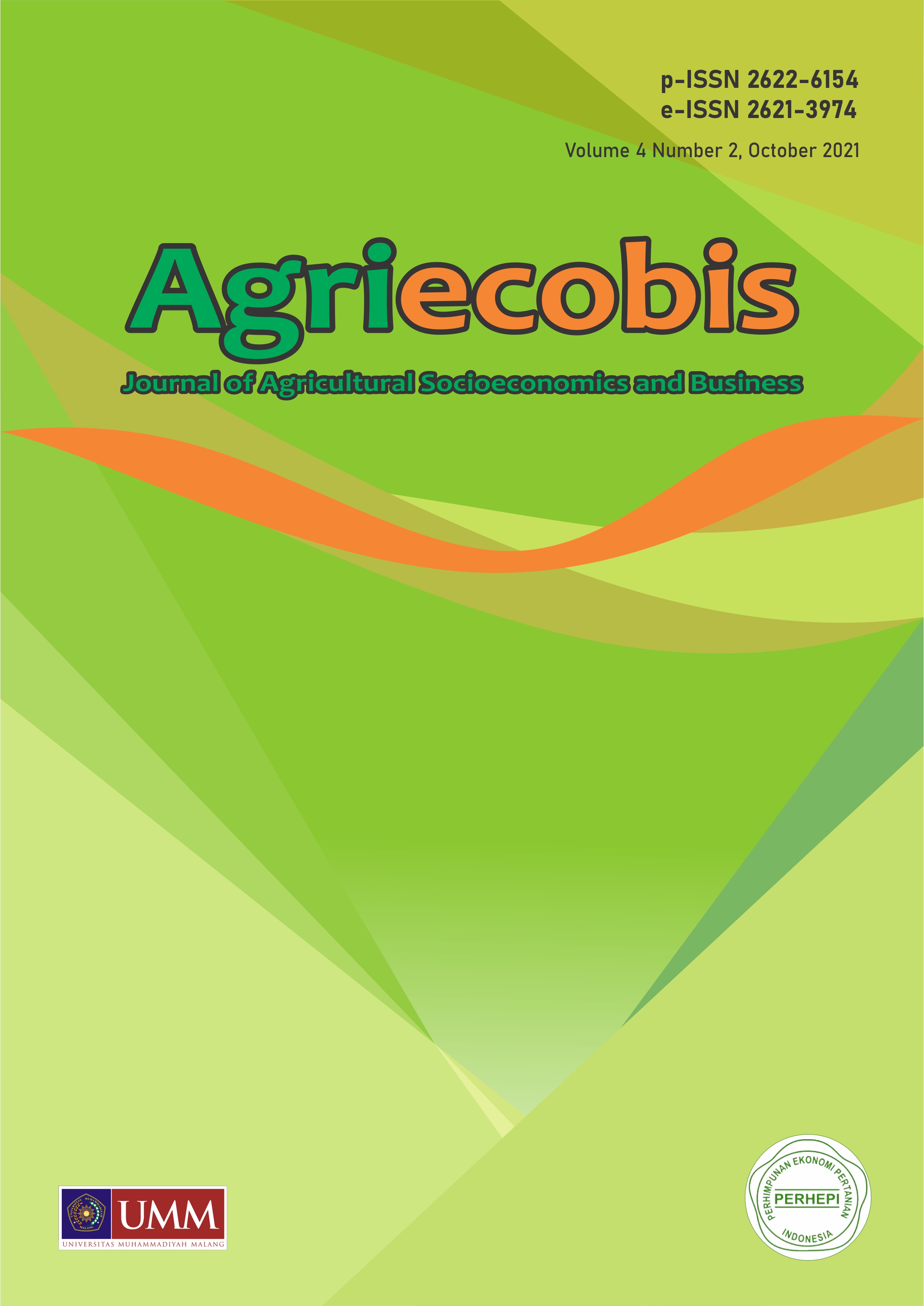Corporate Farming for Farmer Labor Efficiency in Trimulyo Village, Bantul Regency
DOI:
https://doi.org/10.22219/agriecobis.v4i2.15984Keywords:
Corporate farming, Impact, Efficiency, laborAbstract
Agriculture is one of the dominant sectors in the economic structure in Daerah Istimewa Yogyakarta. This is because the agricultural sector contributes to meeting food needs and the supply of industrial raw materials. The corporate farming (CF) program located in desa Trimulyo, Daerah Istimewa Yogyakarta is one of the empowerment programs for farming communities by farming in groups. The purpose of this study was to determine the implementation of the CF program and the impact of the CF program on labor efficiency at the farm level. The research method used was descriptive qualitative and quantitative with t-test. The method of determining the sample was purposive with 30 farmers as respondents. The technique of collecting data was done by observation, interview and questionnaire. The results showed that the CF program is a program by combining several farmer-owned lands into one large area (land consolidation) and carried out jointly in one management from land preparation to harvest using modern agricultural tools and machines. The rice productivity produced by farmers before the CF program was 323.03 Kg/UT or 3,654.05 Kg/Ha. After the existence of the productivity program is 268.13 Kg/UT or 3,032 Kg/Ha. The need for labour in one season prior to the program was 43.8 HOK/UT or 1,464.76 HOK/Ha. The need for labor after the program was 31.52 HOK/UT or 716.79 HOK/Ha. The impact of the CF program on labor efficiency shows no significant difference. This means that the efficiency of the labor before and after the program is the same.
Downloads
References
Afrianika, V. I., Marwanti, S., & Khomah, I. (2020). Analisis Faktor-Faktor yang Mempengaruhi Produksi Usahatani Bawang Merah di Kecamatan Tawangmangu. Agriecobis : Journal of Agricultural Socioeconomics and Business, 3(2), 79. https://doi.org/10.22219/agriecobis.vol3.no2.79-86
Asrizal. (2018). Efisiensi Produksi dan Produktivitas Tenaga Kerja Industri Mikro dan Kecil di Indonesia. Menara Ekonomi, IV(2), 6–11. file:///C:/Users/hp/Downloads/682-1382-1-SM.pdf
Bawono. (2018). Peningkatan Efisiensi Usaha Tani Melalui Model Konsolidasi Corporate Farming. Jurnal Perencanaan DIY.
BPS. (2021). Jumlah Petani Hanya Tersisa 33,4 Juta Orang, Julukan Indonesia Negara Agraris Bisa Hilang.
Dalimunthe, I. M., & Kurnia, G. (2018). Prospek Penerapan Sistem Corporate Farming (Studi Kasus di Koperasi Pertanian Gerbang Emas). Jurnal AGRISEP, 17(1), 11–22. https://doi.org/10.31186/jagrisep.17.1.11-22
Firmana, F., Nurmalina, R., & Rifin, A. (2017). EFISIENSI TEKNIS USAHATANI PADI DI KABUPATEN KARAWANG DENGAN PENDEKATAN DATA ENVELOPMENT ANALYSIS (DEA). Forum Agribisnis, 6(2), 213–226. https://doi.org/10.29244/fagb.6.2.213-226
Iskandar, M. J., & Jamhari, J. (2020). Efficiency of Rice Farming in the Corporate Farming Model in Central Java. AGRARIS: Journal of Agribusiness and Rural Development Research, 6(2). https://doi.org/10.18196/agr.6297
Ismiasih, I. (2020). Persepsi Petani Terhadap Program Corporate Farming Dalam Upaya Peningkatan Produktivitas Padi Di Desa Trimulyo Kabupaten Bantul DIY. file:///C:/Users/hp/Downloads/Prosiding-seminar-Agroindustri-2020.pdf
Mamondol, M. R. (2018). Efisiensi Penggunaan Faktor Produksi Tenaga Kerja dan Modal pada Usahatani Kedelai di Kelurahan Pamona Kecamatan Pamona Puselemba Kabupaten Poso. 2, 1–7. https://doi.org/10.31227/osf.io/gb3jk
Martono, N. (2014). Metode Penelitian Kuantitatif. PT RajaGrafindo Perkasa.
Ministry of Agriculture. (2021). Kementan : Petani Adalah Pelaku Utama Pembangunan Pertanian. https://www.pertanian.go.id/home/?show=news&act=view&id=2158
Sugiyono. (2016). Metode Penelitian Kuantitatif, Kualitatif, R&D. ALFabeta.
Suratiyah, K. (2015). Ilmu Usaha Tani. Penebar Swadaya.
Ulfah, F., Restuhadi, F., & Rosnita, R. (2016). Analisis Efisiensi Produksi Petani Padi Peserta Operasi Pangan
Riau Makmur di Kabupaten Siak. SOROT, 11(1), 61. doi: 10.31258/sorot.11.1.3875
Downloads
Published
How to Cite
Issue
Section
License
Copyright (c) 2021 UMM

This work is licensed under a Creative Commons Attribution-ShareAlike 4.0 International License.
Authors who publish with Agriecobis : Journal of Agricultural Socioeconomics and Business agree to the following terms:
- For all articles published in Agriecobis : Journal of Agricultural Socioeconomics and Business, copyright is retained by the authors. Authors give permission to the publisher to announce the work with conditions. When the manuscript is accepted for publication, the authors agree to automatic transfer of the publishing right to the publisher.
- Authors retain copyright and grant the journal right of first publication with the work simultaneously licensed under a Creative Commons Attribution-ShareAlike 4.0 International License that allows others to share the work with an acknowledgment of the work's authorship and initial publication in this journal.
- Authors are able to enter into separate, additional contractual arrangements for the non-exclusive distribution of the journal's published version of the work (e.g., post it to an institutional repository or publish it in a book), with an acknowledgment of its initial publication in this journal.
- Authors are permitted and encouraged to post their work online (e.g., in institutional repositories or on their website) prior to and during the submission process, as it can lead to productive exchanges, as well as earlier and greater citation of published wor (See The Effect of Open Access).

This work is licensed under a Creative Commons Attribution-ShareAlike 4.0 International License.







